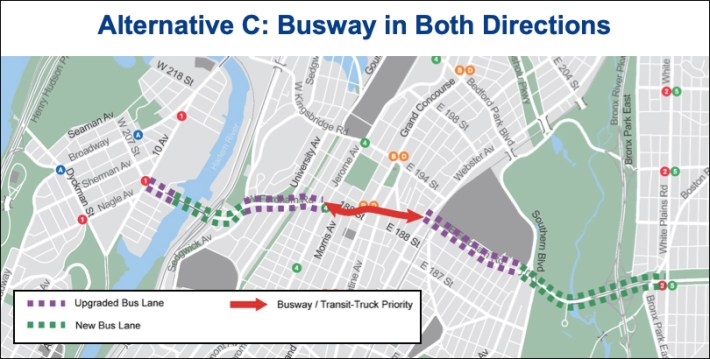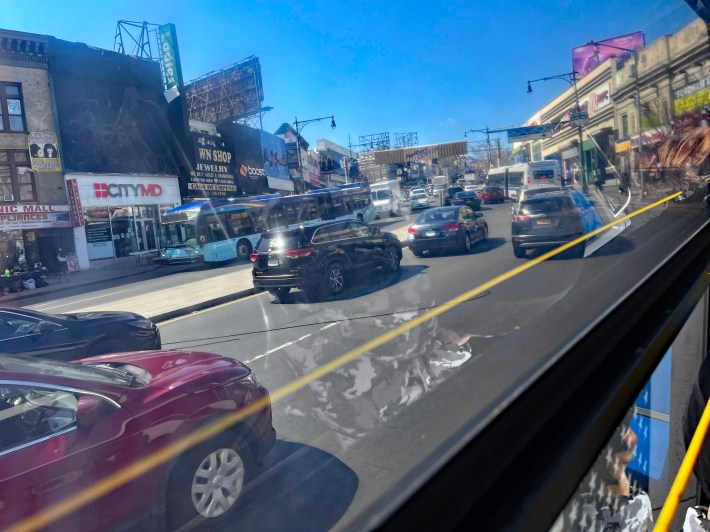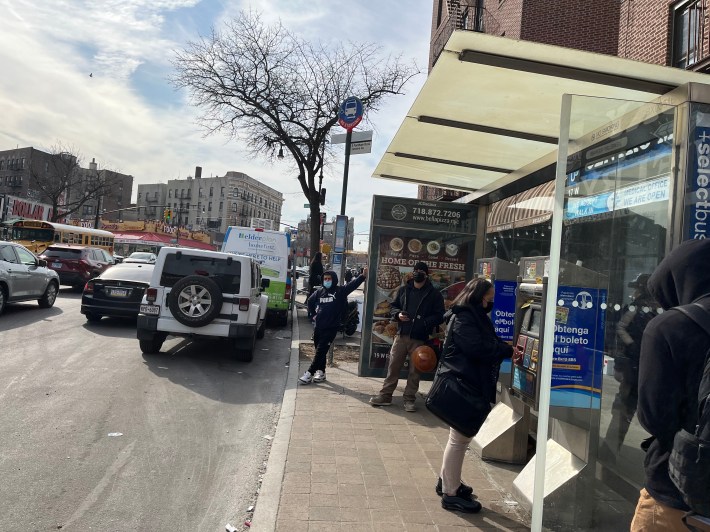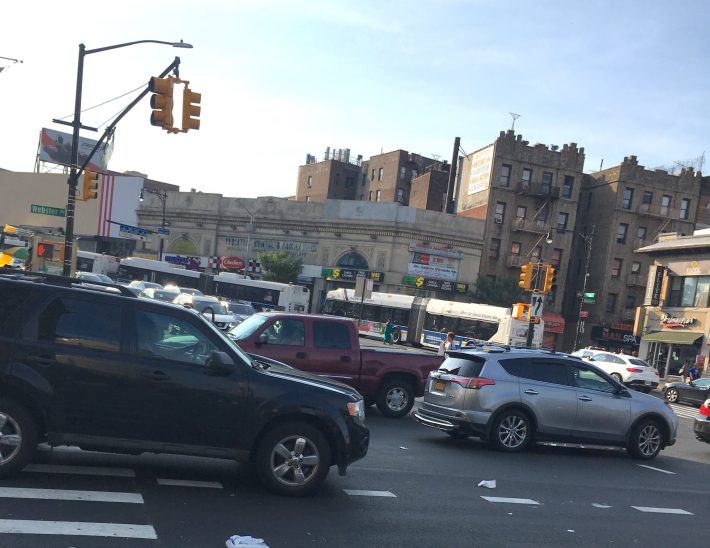Advertisement: Used Dutch Bikes is your one-stop-shop for authentic Dutch bicycles. Choose from classic “grandma bikes” to modern seven-speeds that can haul three kids without breaking a sweat. We carry authentic brands like Gazelle, Batavus, BSP, Burgers, Cortina, and more — available in the USA for the first time!
It's a brawl in the Boogie Down.
Some Fordham Road business leaders are giving their top customers a big "Bronx cheer" — penning a letter to the Department of Transportation opposing a car-free busway along the major shopping corridor.
The honchos painted the proposal — a one- or two-way car-free busway between Morris and Webster avenues — in apocalyptic terms, saying it would be an "existential threat" to the traffic-choked business district, the city's third-largest shopping area.

"Closing any portion of Fordham Road to vehicular traffic will result in many negative consequences to our community," wrote the two top officials of the Fordham Road Business Improvement District, local Council Member Oswald Feliz, and others, in a June 28 letter.

They warned that diverting traffic, "including the thousands of day-trippers from throughout the region who come to shop at our stores, visit their family attending university, or visit the New York Botanical Garden, Bronx Zoo, or Little Italy, would force thousands of cars onto nearby alternative, residential streets, creating endless gridlock and danger for pedestrians." (The letter's use of the term "existential threat" is particularly ironic because climate change — which is exacerbated by overuse of cars and declining support for transit — is often referred to as an "existential threat" to human civilization.)
The plaint, which was first reported by Crain's New York Business, puts the BID and pals squarely on the side of the car-driving day-trippers — as opposed to their main customer base: 86 percent of visitors to the Fordham corridor reported arriving by walking or transit, according to a city report. And the letter writers neglected to mention that Fordham Road is among the areas best served by public transportation in the city and, in fact, the nation, with five bus routes along the road (and more nearby), and four subway lines and the suburban Metro-North Railroad stopping along its length.
Those "day trippers" could arrive by transit like most everyone else, said Riders Alliance spokesman Danny Pearlstein.
"NIMBY drivers are back at it, yet again spreading tired falsehoods to deny tens of thousands of Bronxites faster and more reliable bus commutes," said Pearlstein. "Mayor Adams should disregard the haters and move ahead with a transformational project that's essential to meeting the mandate of the NYC Streets Plan: Fordham Road must be a busway."
The letter, moreover, contravenes the overwhelming sentiment of local road users. Polling done by the DOT before it proposed the reforms showed that 90 percent support for improving the existing bus lanes, including almost three-quarters of non-bus riders. Fully 70 percent of people who live nearby support a car-free busway.
“Bus priority projects have shown to significantly increase bus speeds while maintaining vehicular access to businesses," said DOT spokesman Tomas Garita. "We are committed to delivering fast and reliable bus service for all New Yorkers and we will continue to work closely with local businesses and community leaders to listen to their concerns.”

The letter writers are right in that struggle on Fordham Road is epic. When the city first established Fordham Road's bus lanes during the Bloomberg administration, inaugurating Select Bus Service along the Bx12 Route, the lanes drove a 20-percent jump in bus speeds, a 10-percent hike in bus ridership, and a whopping 71-percent increase in retail sales at local businesses (compared to 23 percent borough-wide), according to the DOT. But the improvements didn't last. Owing to a pervasive lack of enforcement, car drivers now constantly invade Fordham Road's faded bus lanes, making bus riders' trips hellish.
The Bx12 bus, which runs the length of Fordham Road, now averages 7.2 mph and 5.4 mph during peak hours, below the speed of Midtown car traffic. It receives a D grade in the rankings of the Bus Turn Around coalition, arriving on-time only 57 percent of the time, and lost 5 percent of its ridership in the two years before the pandemic.
Many, many Bronx residents suffer daily as a result — not just Fordham Road shoppers, but thousands of workers, hundreds of students who must get to public schools on the route and residents who must take the buses further east to medical and surgical appointments at the Jacobi and Montefiore medical centers.
The five bus routes along Fordham Road serve 85,000 daily riders — and those riders comprise some of the most disadvantaged city residents and rely almost exclusively on public transportation. According to U.S. Census figures, 68,000 people live within a quarter-mile of the proposed busway — almost all of whom (94 percent) are Latino or Black. About a third, 31 percent, live in poverty. Three-quarters of households (74 percent) do not own a car and 77 percent walk, bike, or take transit to work, while only 12 percent commute alone by driving. Almost one-third of bus riders (31.6 percent) commute for more than an hour, while only 16 percent of the local drivers do.
The Bronx letter writers are only the latest such interests to stand against busways, which have helped tens of thousands of riders around the city without spawning gridlock on adjacent roads or setting back retail sales, as opponents have claimed. The busways on 14th Street in Manhattan, Flushing Main Street, Jay Street in Brooklyn and 181st Street in Manhattan all had some opposition, but have all worked well, according to BID leaders, riders and the DOT.
Jennifer Falk, the executive director of the Union Square Partnership, which hosts the 14th Street busway, said that data "indicated that the busway was hugely successful. It decreased bus travel times for riders who needed it most, and increased ridership, bringing new visitors to the Union Square-14th Street district. In addition, it reduced traffic congestion along 14th Street, providing a better pedestrian experience.

"High-quality transit access and connectivity continue to be one of the defining advantages fueling the Union Square-14th Street district’s recovery, and a linchpin of our long-term district vision plan released last year," she said.
The letter writers made pains to note that Fordham Road isn't part of a street grid like 14th Street, and indeed it's not. Fordham Road's irregular intersections and topography, in fact, are even more reason why it should be car free. Fordham Road also ranks as one of the most dangerous strips in the city.
"I grew up near Fordham Road," said Shawn Garcia, Uptown and Bronx organizer at Transportation Alternatives. "The current setup absolutely does not work. The busway is a real way to improve the lives in a community plagued by long commutes, traffic violence, and where the large majority of residents do not own cars. The Bronx has not gotten its fair share of investment over the years, and when the city finally announces a project to improve lives here, we expect our leaders to deliver results, not block its benefits."
The Fordham BID declined to comment.
The dust-up over the busway — and the involvement of a sitting Council member — evokes a similar dynamic in Queens, where two members of the Council want the city to end its test of two paired busways in Jamaica, citing the alleged impact on local businesses.






